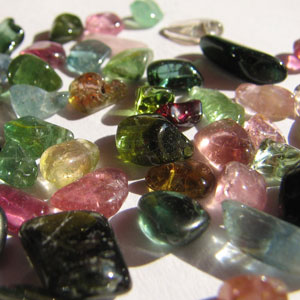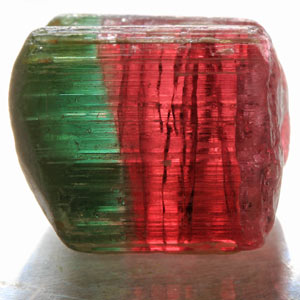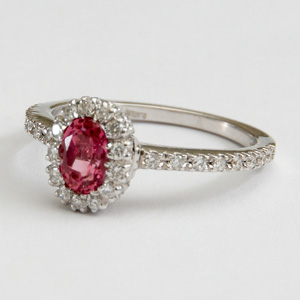tourmaline
Tourmaline, a mesmerising gemstone, derives its name from the Sinhalese word "turamali," meaning "stone with mixed colours." Comprising a complex borosilicate mineral group, tourmaline showcases a remarkable array of colours, making it a favourite among gem enthusiasts and collectors.
Geologically, tourmaline forms in a variety of environments, including granite and pegmatite rocks. Notable sources include Brazil, Madagascar, and Afghanistan, each yielding unique colour varieties.
What sets tourmaline apart is its exceptional range of colours, often displaying bi-coloured or tri-coloured crystals. Tourmalines are renowned for their intricate internal growth structures, which can create striking cat's-eye and watermelon-like patterns when cut and polished.
One interesting fact about tourmaline is its unique property of pyroelectricity, meaning it can generate an electrical charge when heated or subjected to pressure changes. This property has led to its use in scientific instruments and mineralogical studies. With its vibrant hues and fascinating properties, tourmaline continues to captivate gem connoisseurs worldwide.
Click on the terms in the table below to discover their meaning



Click on the terms in the table below to discover their meaning
| Name | Tourmaline |
|---|---|
| Category | Cyclosilicate |
| Chemical Formula |
|
| Note: ▢ represents an atomic vacancy | |
| IMA Symbol | Tur |
| Crystal System | Trigonal |
| Crystal Habit | Prismatic to acicular, with prominent trigonal prism and pyramid, commonly hemimorphic, striated; also radial, fibrous, and massive |
| Twinning | Rare |
| Cleavage | Poor |
| Fracture | Conchoidal to uneven |
| Tenacity | Brittle |
| Hardness (Moh's Scale) |
7 |
| Specific Gravity | 2.90 - 3.10 |
| Diaphaneity | Transparent to translucent |
| Colour | Colourless, white, yellow, orange, red, pink, blue, green, brown, black; zoning common parallel to trigonal outline |
| Streak | White or light brown |
| Lustre | Vitreous to resinous |
| Optical Class | Uniaxial (-) |
| Refractive index | nω = 1.634 - 1.661 and nϵ = 1.612 - 1.632 (Dravite) |
| nω = 1.633 - 1.651 and nϵ = 1.615 - 1.630 (Elbaite) | |
| nω = 1.660 - 1.671 and nϵ = 1.635 - 1.650 (Schorl) | |
| Birefringence | δ = 0.014 - 0.040 |
| Dispersion | Rd = 0.017 |
| Pleochroism | O = pale yellow; E = colourless, yellowish, greenish, brownish (Dravite) |
| O = pink, pale green, pale to deep blue; E = colourless, yellow, olive-green, purplish (Elbaite) | |
| O = yellow-brown; E = pale yellow, pale brown (Schorl) | |
| Clarity | Type II or Type III |
| Notable Varieties | Rubellite, Indicolite, Verdelite, Paraíba Tourmaline, Watermelon Tourmaline, Schorl, Chrome Tourmaline, Cat's Eye Tourmaline (displays chatoyancy), Achroite |
References
Hudson Institute of Mineralogy. (2023). Tourmaline. Retrieved from Mindat.org: https://
Mineralogical Society of America. (2001). Dravite. In J. W. Anthony, R. A. Bideaux, K. W. Bladh, & M. C. Nichols (Eds.), Handbook of Mineralogy. Chantilly, VA 20151-1110, USA: Mineralogical Society of America. Retrieved from https://
Mineralogical Society of America. (2001). Elbaite. In J. W. Anthony, R. A. Bideaux, K. W. Bladh, & M. C. Nichols (Eds.), Handbook of Mineralogy. Chantilly, VA 20151-1110, USA: Mineralogical Society of America. Retrieved from https://
Mineralogical Society of America. (2001). Schorl. In J. W. Anthony, R. A. Bideaux, K. W. Bladh, & M. C. Nichols (Eds.), Handbook of Mineralogy. Chantilly, VA 20151-1110, USA: Mineralogical Society of America. Retrieved from https://